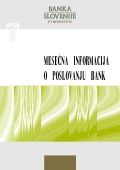Svet Banke Slovenije je obravnaval gradivo Mesečna informacija o poslovanju bank v letu 2017
Bilančna vsota je po začasnih podatkih konec decembra 2017 znašala 37,9 mrd EUR, kar pomeni 2,4-odstotni porast v letu 2017. V strukturi naložb se je povečal delež posojil nebančnemu sektorju na račun nižjih naložb v vrednostne papirje. Banke so v svojih aktivah ohranile tudi razmeroma visok delež najbolj likvidnih oblik naložb. Na strani virov financiranja so na deležu dodatno pridobile vloge nebančnega sektorja ob znižanju financiranja na finančnih trgih.
Rast posojil nebančnemu sektorju se je decembra 2017 znižala na 4,8% medletno. Na znižanje rasti je vplival zlasti bazni učinek močnega prirasta posojil nefinančnim družbam v decembru 2016. Medletna rast posojil nefinančnim družbam se je z novembrskih 7,8% decembra znižala na 2,2%, k čemur je poleg prevladujočega baznega učinka prispevalo tudi znižanje obsega posojil ob koncu leta 2017. Delež posojil nefinančnim družbam v bančnih bilancah je bil decembra lani na eni od zgodovinsko najnižjih ravni. Znašal je le dobro petino bilančne vsote, po obsegu je za posojili gospodinjstvom zaostajal za 1,1 mrd EUR.
Prirast posojil celotnemu nebančnemu sektorju je v letu 2017 dosegel slabo milijardo EUR, večino oziroma 60% je prispeval prirast posojil gospodinjstvom. Rast posojil gospodinjstvom se je po visoki rasti tekom leta, v zadnjih mesecih umirjala in decembra znižala na 6,8% medletno. Znižanje rasti je bilo prisotno pri vseh vrstah posojil: pri potrošniških na 12,9 %, pri stanovanjskih na 4,8%. V zadnjem delu leta je zaznati zniževanje novoodobrenih posojil, zlasti posojil sklenjenih s fiksno obrestno mero, ter krajšanje ročnosti pri novoodobrenih dolgoročnih posojilih. Ob razmeroma visoki rasti posojil gospodinjstvom so banke lani, po začetni zaostritvi v prvem četrtletju, kreditne standarde ohranjale nespremenjene oziroma na doseženih višjih ravneh.
Vloge nebančnega sektorja so v letu 2017 porasle za 5,3% oziroma za 1,4 mrd EUR, pri čemer so dve tretjini prirasta prispevale vloge gospodinjstev. Povečale so se le vpogledne vloge, ki so ob koncu leta predstavljale 68,5% vseh vlog nebančnega sektorja in se približale polovici bilančne vsote bančnega sistema. Vloge gospodinjstev so se v letu 2017 povečale za 5,6%, nominalno za 938 mio EUR, v sezonsko močnem decembru za 180 mio EUR. V zadnjem četrtletju so nekatere banke povišale povprečne obrestne mere za novo sklenjene vloge gospodinjstev nad 1 letom, kar je nekoliko umirilo krčenje dolgoročnih vlog. Lani se je nadaljevala visoka rast vlog podjetij pri bankah, katerih obseg je konec leta dosegel 6,1 mrd EUR.
Kakovost bančnih naložb se je tudi v letu 2017 izboljševala. Delež nedonosnih izpostavljenosti (NPE) se je do decembra znižal za 2,5 odstotne točke, na 6,0% oziroma v obsegu za slabo milijardo EUR, na 2,5 mrd EUR. Banke so bolj intenzivno reševale nedonosne terjatve do nerezidentov, predvsem z njihovim odpisovanjem ob koncu leta. Največji obseg NPE se je ohranil v terjatvah do nefinančnih podjetij, v višini 1,7 mrd EUR, čeprav je izboljšanje kakovosti naložb opazno tudi na tem segmentu.
Banke so v letu 2017 poslovale z dobičkom, ki je, po začasnih podatkih, pred obdavčitvijo znašal 441 mio EUR in je za petino presegel predlanskega. Pri tem so se vsi elementi ustvarjanja dohodka še naprej zmanjševali, bruto in neto dohodek, neto obrestni in neobrestni prihodki. Vendar se je ob rasti kreditiranja močno upočasnilo upadanje neto obrestnih prihodkov. Banke so realizirale pozitivno rast iz neto opravnin, ki predstavljajo najpomembnejši del neto neobrestnih prihodkov. Na strani stroškov je k dohodku ugodno prispevalo neto sproščanje oslabitev in rezervacij, ki je na ravni bančnega sistema v celem letu 2017 doseglo 40 mio EUR. Negativen vpliv na dohodek je imela ponovna rast operativnih stroškov, po večletnem obdobju zmanjševanja.
Bančni sistem ohranja velik obseg kratkoročne presežne likvidnosti, dober likvidnostni položaj pa se odraža tudi v ohranjanju visokega količnika likvidnosti prvega razreda, visokega deleža prostega sklada finančnega premoženja in deleža sekundarne likvidnosti v bilančni vsoti, ki je decembra lani znašal 19,7%. Ob tem se nadalje spreminja struktura sekundarne likvidnosti v smeri naraščanja tujih tržnih vrednostnih papirjev primernih za zastavo pri Evrosistemu.
Kapitalski položaj slovenskega bančnega sistema ostaja dober kljub rahlemu zmanjševanju kapitalske ustreznosti v prvih treh četrtletjih 2017. Ta je konec septembra lani na posamični osnovi znašala 20,2%, na konsolidirani osnovi pa 18,4%. Postopno zmanjševanje kapitalske ustreznosti je posledica krepitve kreditne aktivnosti in s tem povečevanja kapitalskih zahtev, ki se večajo relativno bolj kot kapital.
Mesečna informacija o poslovanju bank

